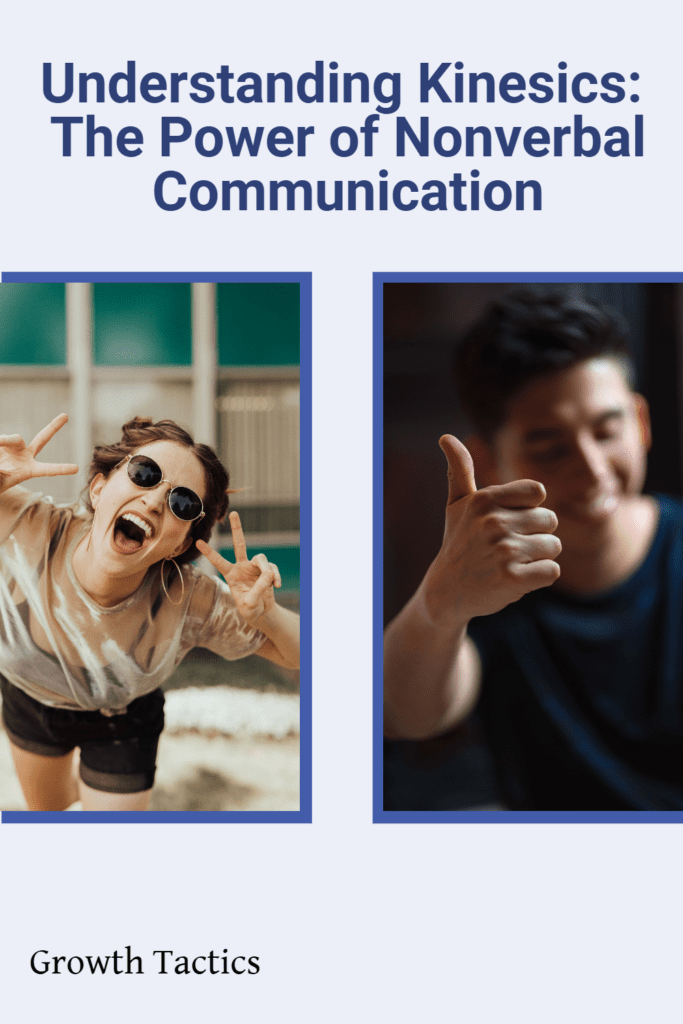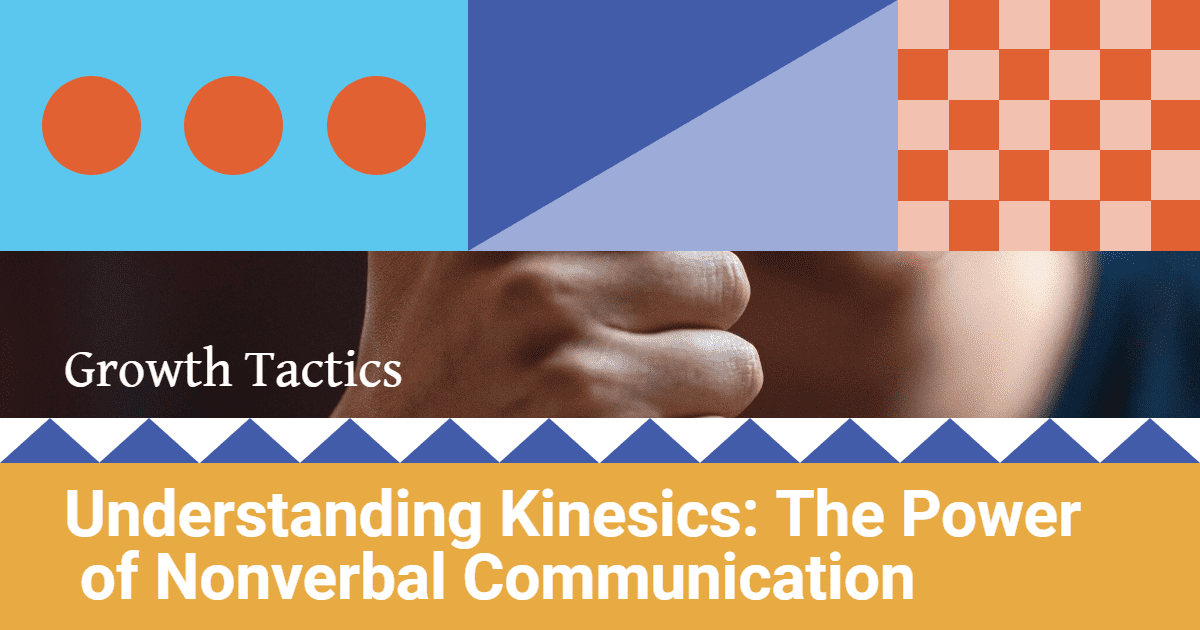Kinesics refers to human body movement, gestures, and facial expressions as communication. It involves using the body to convey meaning and is a category of nonverbal communication or body language. Kinesic communication can be intentional or unintentional and varies greatly across cultures and individuals.
Kinesics is often associated with the work of anthropologist Ray Birdwhistell, who coined the term as well as introduced the concept of proxemics, which examines the use of space as a form of nonverbal communication.
Jump To Section
Understanding Kinesic Communication

Kinesics is an essential aspect of interpersonal communication. It can be used to convey information, reinforce the meaning of verbal communication, and indicate interest, thoughts, and feelings. However, it can also be misinterpreted in social situations, leading to confusion and misunderstandings.
For example, avoiding eye contact can sometimes be interpreted as dishonesty or disinterest. In contrast, making sustained eye contact can be a sign of interest and attentiveness. Similarly, different kinesic movements, such as the use of hand gestures or the posture of a person, can convey happiness, sadness, or power dynamics in a social context.
Research has shown that people tend to remember nonverbal signals more accurately than verbal ones. In one study, participants who were shown a video with the sound turned off were more likely to accurately recall the content of the message when nonverbal cues such as facial expressions and gestures were present.
The Importance of Body Language in Communication

Body language is a powerful tool that enhances our communication, often conveying more than words ever could. In fact, studies suggest that up to 93% of our communication is nonverbal, with body language playing a significant role in how we express our feelings and intentions. Effective body language can help us build rapport, establish trust, and create a positive atmosphere in conversations.
For instance, an open stance and relaxed posture can make us appear more approachable, while crossed arms might signal defensiveness or discomfort. Additionally, being aware of our body language as well as that of others allows us to pick up on subtle cues, such as shifts in mood or changes in interest.
This heightened awareness can significantly improve our interactions, enabling us to respond appropriately and empathetically, making body language not just important but essential in successful communication.
Examples of Kinesics and Types of Nonverbal Communication
Facial Expressions: The Window to Our Emotions
Have you ever seen someone’s face light up with a smile or crinkle with a frown? Facial expressions are an incredible part of kinesics, allowing us to convey a wide range of emotions. For example, a genuine smile can indicate happiness, while a furrowed brow might imply confusion or concern. By paying attention to facial expressions, you can better understand someone’s feelings and connect with them on a deeper level.

Gestures: Amplifying our Words
Sometimes, our gestures can say more than words ever could. Imagine someone using their hands to illustrate an idea or point. They’re harnessing the power of kinesics to enhance their verbal messages. For instance, a thumbs-up can express approval, while a hand wave can signal goodbye or attract attention. These simple yet powerful gestures can add an extra layer of meaning to our conversations.
Eye Contact: Building Trust and Connection
They say the eyes are the windows to the soul, and in the world of kinesics, eye contact plays a significant role. Maintaining eye contact while listening or speaking shows attentiveness and builds trust. On the other hand, avoiding eye contact might be seen as disinterest or even deception. The power of eye contact lies in its ability to establish a genuine connection with others.
Posture: Conveying Confidence and Attitude
How we hold ourselves can speak volumes about our confidence and attitude. Pay attention to someone’s body posture, and you’ll uncover valuable insights into their emotions and intentions. A person standing tall with shoulders back exudes confidence, while slouching might suggest discomfort or indifference. Your posture can even influence how others perceive you, so it’s worth considering how you carry yourself in different situations.
Cultural Variations: The Dance of Gestures
Now, it’s important to note that kinesics can vary across cultures. What may be seen as a friendly gesture in one culture might be perceived differently in another. For example, in some countries, a thumbs-up sign is a positive gesture, while in other places, it can be offensive. Being aware of these cultural variations enhances our understanding of the nuances of nonverbal communication.
Putting it All Together
These forms of nonverbal communication give us a glimpse into the incredible power of nonverbal communication. From facial expressions to gestures, eye contact to posture, our bodies are constantly sending nonverbal messages. By paying attention to these cues, we can better understand others, forge deeper connections, and communicate more effectively.
Communicating More Effectively with Kinesics

Mastering Gestures and Facial Expressions
Gestures and facial expressions are like the superheroes of kinesics, silently communicating what words sometimes cannot. Pay attention to your hand movements and the emotions expressed on your face. A nod can show agreement, while a raised eyebrow might indicate surprise or skepticism. By being mindful of these gestures and expressions, you can reinforce your verbal message and ensure your true intentions are understood.
The Eyes Have It: Eye Contact and Connection
Ever heard the saying, “The eyes are the windows to the soul”? Well, that couldn’t be truer in the realm of nonverbal communication. When engaged in a conversation, maintaining good eye contact shows interest, attentiveness, and respect. It creates a connection and lets the other person know that you’re fully present in the moment. So, be sure to meet their gaze and let your eyes do the talking.

Harnessing the Power of Posture
Believe it or not, your posture can make or break your communication efforts. By standing tall with your shoulders back, you exude confidence and project a positive image. On the other hand, slouching can give off an impression of disinterest or lack of self-assurance. So, straighten up, pull those shoulders back, and let your body language speak volumes about your confidence and attitude.
Adapting to Cultural Differences
It’s important to remember that kinesics can vary across cultures. What may be a friendly gesture in one culture might be considered inappropriate or offensive in another. So, it’s crucial to be aware of cultural differences and adapt your nonverbal communication accordingly. Take the time to learn about the customs and practices of the people you interact with, and you’ll be able to navigate cross-cultural communication with ease.
Practicing Mindful Communication
Now that you have some key insights into leveraging kinesics for effective communication, it’s time to put it into practice. Start by being more aware of your own nonverbal cues and how they align with your intended message. Observe the nonverbal cues of others and use them as valuable clues to better understand their thoughts and emotions. By approaching communication with mindfulness and attention to nonverbal cues, you’ll find yourself connecting more deeply and building stronger relationships.
Take Your Communication Skills to the Next Level
By incorporating kinesics into your communication toolkit, you can elevate your interpersonal interactions to new heights. Gestures, facial expressions, eye contact, and posture all contribute to the rich tapestry of nonverbal communication. So, be present, be mindful, and let your body language do the talking. Get ready to wow the world with your newfound knowledge of kinesics and communicate your way to success!
In Conclusion
In closing, we can see that kinesics play a crucial role in communication, whether intentional or unintentional, across cultures and individuals. By paying attention to nonverbal cues, we can better communicate with each other and determine the veracity of the messages we receive. We can use our bodies to convey our thoughts and feelings, convey meaning, and interact with others. Understanding kinesics can help us communicate better and build better relationships with those around us.
Key Takeaways:
- Kinesics refers to the study of human body movement, gestures, and facial expressions as a form of communication.
- Kinesics is an essential aspect of interpersonal communication, and it can be used to convey information, reinforce the meaning of verbal messages, and indicate interest, thoughts, and feelings.
- Eye contact, posture, gestures, and facial expressions are significant parts of kinesic communication.
- Examples of kinesics include nodding, bowing, patting someone on the back, shrugging shoulders, and using hand gestures to emphasize a point.
- Kinesic signals can vary depending on the social situation and cultural context, so it’s essential to be aware of these differences.








